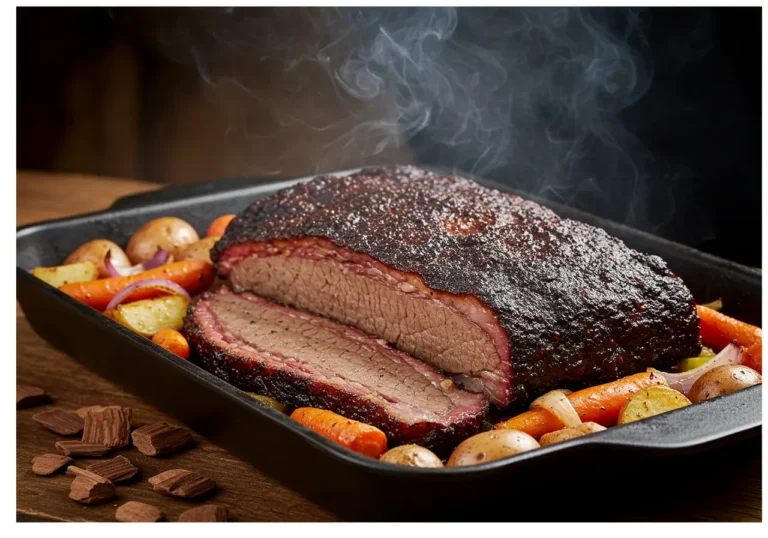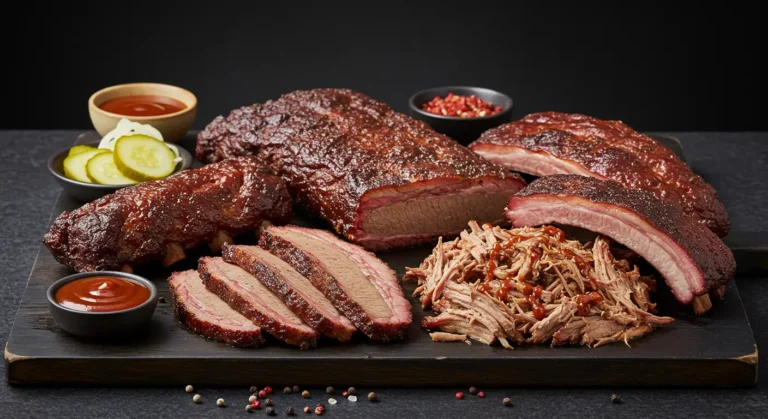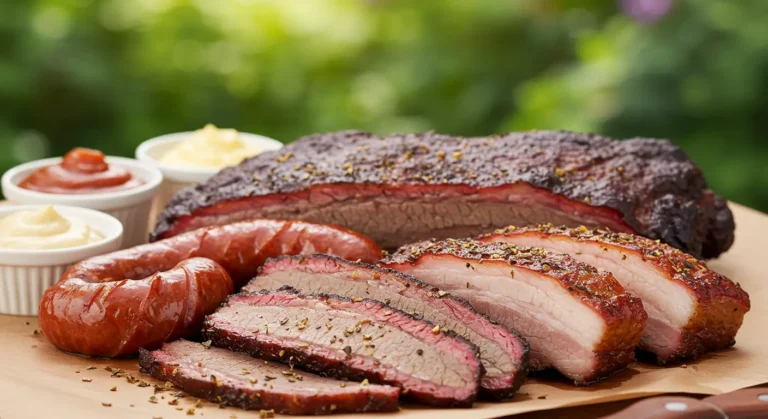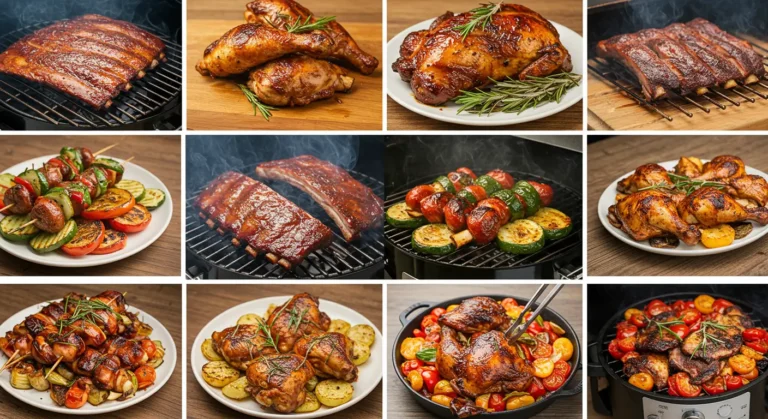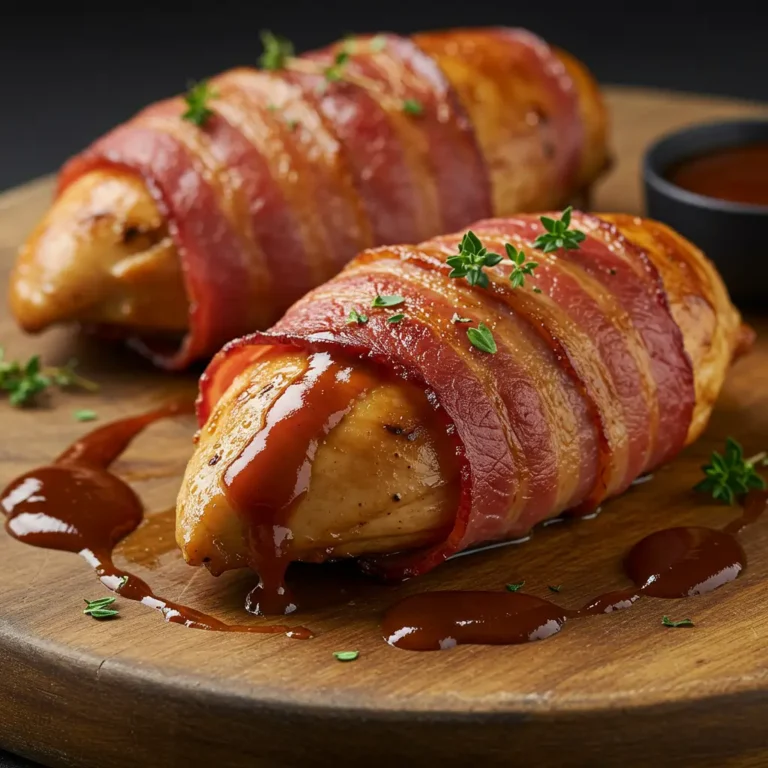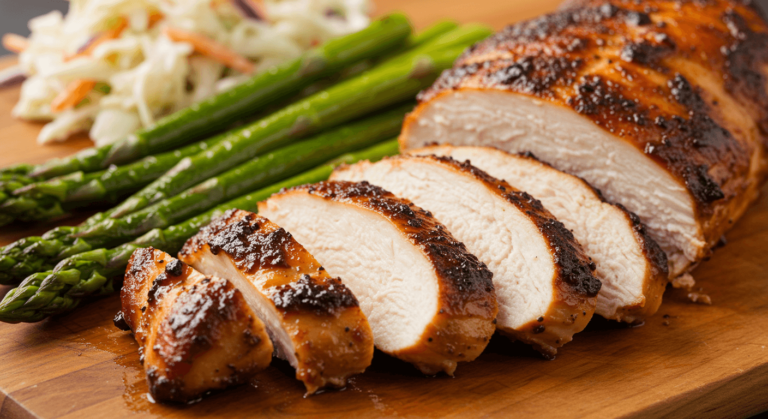How to smoke beef short ribs step-by-step for beginners
Barbecue lovers know that smoked beef short ribs are the top choice for smoker recipes. These cuts become delicious when cooked with care and patience. Smoking beef short ribs turns backyard cooking into a special art.
Learning to smoke beef short ribs is a journey. It’s about turning tough meat into tender, tasty barbecue. This guide will help you make restaurant-quality smoked short ribs in your backyard.
Key Takeaways
- Learn essential techniques for smoking beef short ribs
- Understand the importance of meat selection and preparation
- Master temperature control and smoke management
- Discover professional-level seasoning and rub techniques
- Develop skills to create tender, flavorful barbecue beef
Understanding Beef Short Ribs: Cuts and Quality Selection
Choosing the right beef rib cuts is key to delicious smoked short ribs. The meat’s quality greatly affects the taste and texture of your dish. Knowing about beef cuts helps you pick the best at the butcher or store.
- Plate Short Ribs: Larger, meatier cuts from the belly area
- Chuck Short Ribs: Shorter, more marbled cuts from the shoulder region
- Back Ribs: Leaner cuts from the upper rib section
Prime vs Choice Grade Selection
The grade of beef is very important. Prime beef is the highest quality, with lots of marbling for tender, tasty results. Choice beef is more affordable, with good marbling and quality.
What to Look for When Buying Short Ribs
When picking short ribs, look for these things:
- Consistent marbling throughout the meat
- Bright red coloration
- Fresh appearance with little excess moisture
- Thick meat layer over the bones
Pro tip: Get to know a local butcher. They can show you the best prime and choice beef for smoking. They’ll help pick the right cuts for your cooking method.
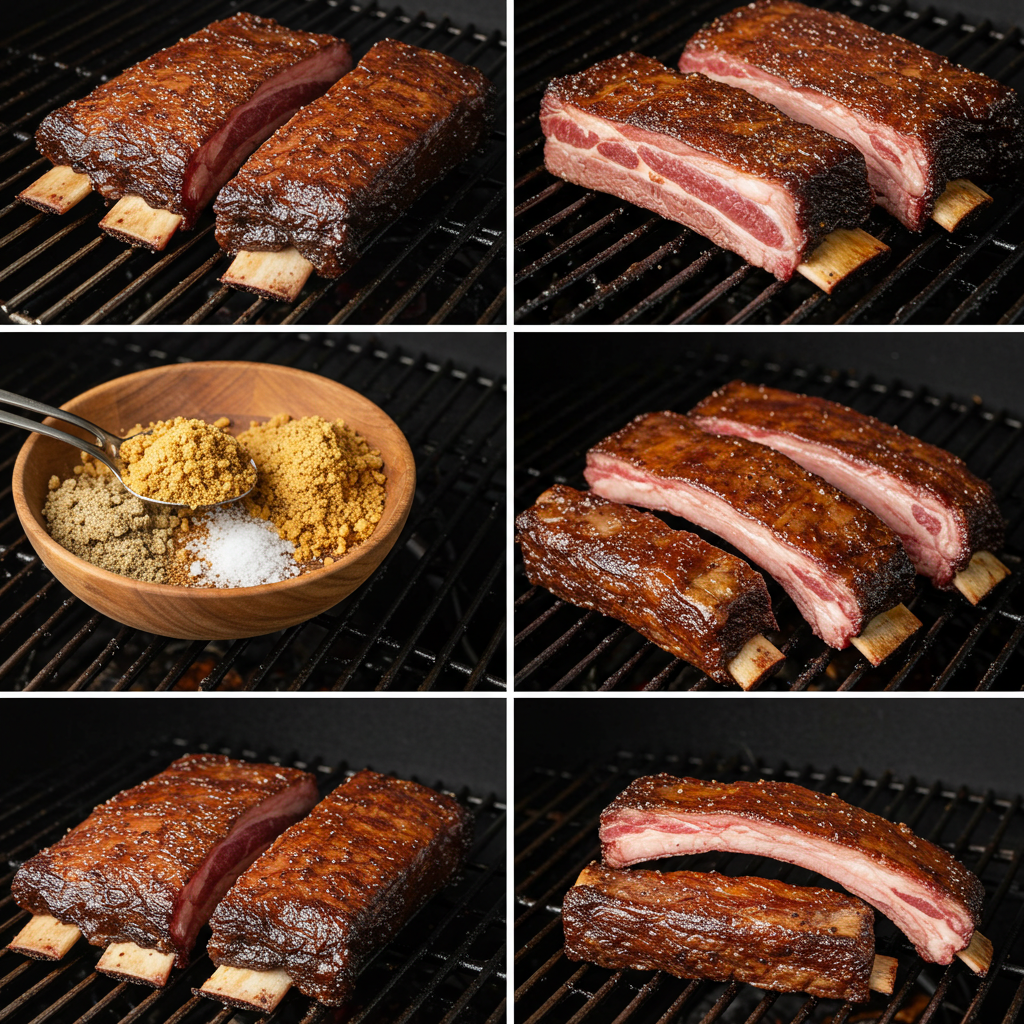
Essential Equipment and Tools for Smoking Short Ribs
Choosing the right smoker is key to making tasty beef short ribs. Different smokers can change how your food turns out. Beginners need to know the basic tools for great smoked meats.
There are many smoker types for all skill levels and tastes:
- Charcoal smokers: Traditional and provides deep smoky flavor
- Electric smokers: Easy to use and maintain consistent temperatures
- Pellet smokers: Offers precise temperature control and wood-fired taste
- Offset smokers: Great for experienced BBQ enthusiasts
A good meat thermometer is a must for smoking short ribs. It lets you check the meat’s internal temperature. This ensures your meat is cooked just right every time.
| Smoking Equipment | Purpose | Recommended for |
|---|---|---|
| Digital Meat Thermometer | Temperature monitoring | All skill levels |
| Heat-Resistant Gloves | Safety and handling | Beginners and pros |
| Spray Bottle | Moisture maintenance | Advanced smokers |
Good smoking gear can make a big difference in your short rib cooking. Choose tools that match your skill level and cooking style.
Preparing Your Smoker for the Perfect Cook
Smoking beef short ribs needs careful smoker temperature control and preparation. The right setup can turn a simple meal into a delicious experience. Knowing your smoker well is essential for tender, flavorful results.
Starting with your equipment and creating the best cooking environment is key. Your choice of heat zones and wood will greatly affect the dish’s taste and texture.
Temperature Control Basics
Keeping a steady smoker temperature is vital for perfect short ribs. Most smokers do best at 225-250°F. Here are some tips for reliable temperature control:
- Use a digital thermometer with multiple probes
- Check vents and airflow regularly
- Avoid opening the smoker too frequently
- Keep a water pan to stabilize temperature
Wood Selection and Smoke Management
Choosing the right smoking wood can make your short ribs amazing. Different woods give unique flavors:
- Hickory: Strong, classic barbecue flavor
- Oak: Medium intensity, versatile profile
- Pecan: Sweet, mild nutty undertone
- Apple: Mild, fruity subtlety
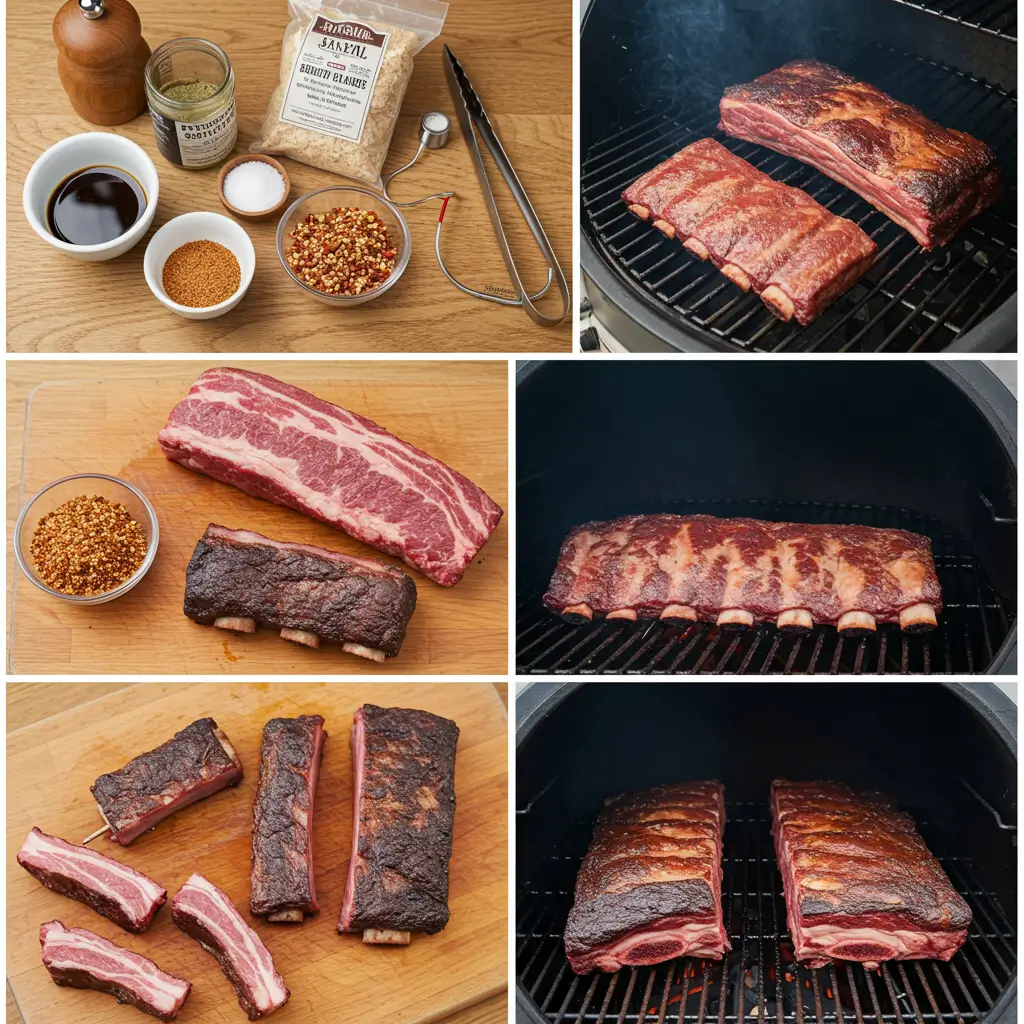
Setting Up Heat Zones
Creating heat zones helps control cooking. Divide your smoker into areas for direct and indirect heat. This method prevents burning and ensures even cooking of your beef short ribs.
By mastering these basic smoker preparation tips, you’ll be ready to make delicious, tender short ribs. These will impress even the most picky barbecue fans.
How to Smoke Beef Short Ribs: The Complete Process
Mastering the smoking process for beef short ribs takes precision and patience. The journey starts with selecting the right ribs and using the right techniques. These steps turn tough cuts into tender, flavorful dishes.
- Remove excess fat and silver skin
- Pat ribs dry with paper towels
- Trim any uneven edges for consistent cooking
The smoking techniques for beef short ribs involve several key stages:
- Trimming: Clean up the meat surface carefully
- Seasoning: Apply a generous dry rub
- Preheating: Set smoker to 225-250°F
- Smoking: Place ribs bone-side down
Understanding internal meat temperatures is key for perfect results:
| Temperature Stage | Internal Temp (°F) | Cooking Status |
|---|---|---|
| Initial Cooking | 165-175 | Low and Slow |
| Wrapping Stage | 185-195 | Begin Tenderizing |
| Finished | 200-205 | Tender and Ready |
Pro tip: Use a reliable meat thermometer to track progress and prevent overcooking. Patience during the smoking process ensures maximum tenderness and rich flavor in your beef short ribs.
Creating the Perfect Dry Rub for Short Ribs
Making a great beef rib rub is like an art form. It turns simple short ribs into a tasty treat. For those who love barbecue, a good dry rub is key to improving their skills.
Essential Components of a Classic Beef Rib Rub
A memorable dry rub starts with the right mix of ingredients. Pitmasters use spices that enhance the flavor of beef short ribs.
- Kosher salt: The primary seasoning base
- Brown sugar: Creates caramelization and bark
- Black pepper: Adds sharp, aromatic notes
- Paprika: Provides color and mild sweetness
- Garlic powder: Introduces depth of flavor
Advanced Flavor Exploration
Improving your rub means trying new spice mixes. Professional pitmasters often add unique ingredients to their dry rubs.
| Flavor Profile | Key Ingredients | Unique Twist |
|---|---|---|
| Spicy Southwest | Chili powder, cumin | Smoked chipotle powder |
| Coffee Infused | Ground coffee, cocoa powder | Espresso grounds |
| Herbs de Provence | Dried thyme, rosemary | Lavender flowers |
Mastering Rub Application Techniques
Applying the rub right is key. Coat the meat well, making sure it’s evenly covered. This lets the spices soak deep into the meat. Gently pat the rub to help it stick to the ribs.
Pro tip: Let the rubbed ribs rest for 30-60 minutes before smoking. This lets the flavors mix and creates a tasty crust during cooking.
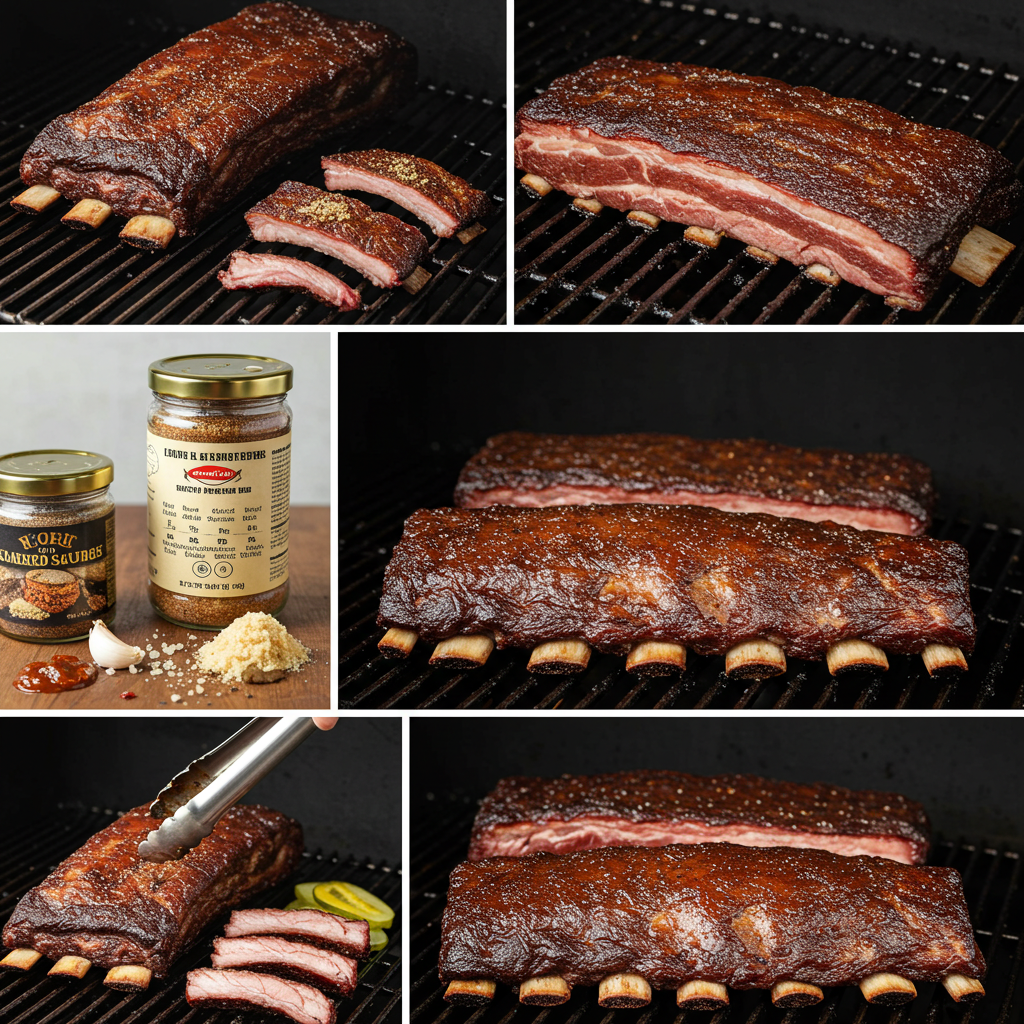
Monitoring Temperature and Smoke Levels
Mastering meat temperature and smoke management is key for smoking beef short ribs. Getting the cooking time right can turn a simple meal into a masterpiece. Digital thermometers are your best friend for achieving perfect results.
Accurate temperature tracking involves several important steps:
- Smoker temperature: Keep it steady at 225-250°F
- Internal meat temperature: Watch it reach your desired doneness
- Probe placement: Put the thermometer in the thickest part of the meat
Managing smoke is also critical. Too little smoke makes the meat taste bland, while too much can make it bitter. Aim for a thin, blue smoke that adds a nice wood flavor without overpowering the beef.
| Temperature Stage | Target Range | Recommended Action |
|---|---|---|
| Initial Smoking | 225-250°F | Maintain steady heat |
| Stall Period | 160-170°F | Monitor closely, avoid temperature fluctuations |
| Final Cooking | 195-205°F | Prepare for possible wrapping |
Pro pitmasters suggest checking temperatures every 30-45 minutes. Use several thermometers to track both the smoker and meat temperatures at once. This method helps you control the cooking process and avoid surprises.
Mastering the Stall and Wrapping Techniques
Smoking beef short ribs is a challenge for barbecue lovers. The dreaded barbecue stall is a critical phase that tests patience and skills. It’s a hurdle even experienced pitmasters face.
Understanding the Stall Period
The barbecue stall happens when meat’s internal temperature stops rising. Moisture evaporation cools the meat’s surface, causing a temperature plateau. This can last several hours, usually around 155-165°F.
Effective Wrapping Strategies
The Texas crutch method is a powerful solution for the stall. Wrapping meat in butcher paper or aluminum foil helps overcome the temperature plateau. It also prevents moisture loss.
- Butcher Paper: Allows some smoke penetration while protecting the meat
- Aluminum Foil: Creates a tighter seal, accelerating cooking time
- Timing: Typically wrap when internal temperature reaches 160-165°F
Finishing Methods
After wrapping, continue smoking until the short ribs are tender. Aim for an internal temperature of 200-205°F. This ensures a melt-in-your-mouth texture.
| Wrapping Method | Pros | Cons |
|---|---|---|
| Butcher Paper | Maintains bark texture | Slower cooking process |
| Aluminum Foil | Fastest cooking time | Softer bark texture |
Pro tip: Always monitor internal temperature and adjust wrapping technique based on your specific smoker and meat characteristics.
Tips for Achieving Tender, Juicy Results
Creating tender beef ribs is more than basic smoking skills. Professional pitmasters know the secret to juicy meat. It’s all about careful preparation and precise cooking techniques.
Mastering barbecue tips for short ribs involves understanding several critical factors:
- Select high-quality meat with good marbling
- Choose the right internal temperature for tenderness
- Allow sufficient resting time after smoking
- Use proper slicing techniques
Temperature control is key to achieving a melt-in-your-mouth texture. Keeping a consistent low and slow cooking environment prevents moisture loss. This ensures your beef ribs stay succulent.
| Technique | Impact on Meat Texture |
|---|---|
| Low Temperature Smoking | Breaks down connective tissues |
| Proper Resting Period | Redistributes internal juices |
| Wrapping Method | Prevents excessive moisture loss |
Professional smokers recommend letting your tender beef ribs rest for 20-30 minutes after cooking. This step is critical. It allows juices to redistribute, ensuring maximum flavor and tenderness in every bite.
Conclusion
Mastering smoked beef short ribs is an art that needs dedication and practice. It starts with knowing the basics of smoking, like picking the right cut and controlling temperature and smoke. Every try gets you closer to making those tender, flavorful ribs that wow everyone.
Patience and detail are key to amazing smoked beef short ribs. Try different woods, rubs, and cooking ways to find your style. Don’t get down if it doesn’t work out at first. Every pitmaster began where you are, learning and improving with each try.
Great barbecue is more than cooking; it’s a passion that brings people together. Start with this guide, but add your own twist. Your creativity and eagerness to learn will turn good ribs into a memorable dish.
If you grill at home or dream of being a pit master, the quest for perfect smoked beef short ribs is thrilling. Keep exploring, stay curious, and most importantly, enjoy making delicious barbecue that tells a story with every bite.
FAQ
Have You Tried This Recipes!
There are no reviews yet. Be the first one to write one.

